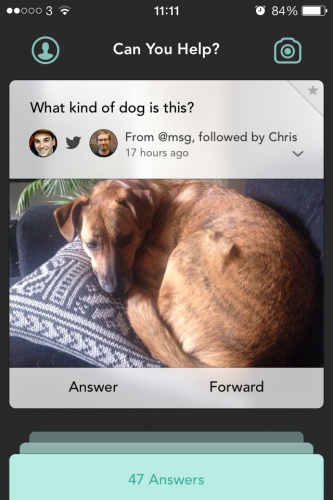“Let’s help each other”
Yesterday saw the official unveiling of Jelly, an app for smartphones which allows users to ask questions, accompanied by a photo, to their extended social networks.
Humanity is connected like never before. In fact, recent white papers have concluded that the proverbial “six degrees of separation” is now down to four because of social networking and mobile phones. It’s not hard to imagine that the true promise of a connected society is people helping each other.
http://blog.jelly.co/post/72563498393/introducing-jelly
 An example could be whilst going for a walk, you spot something unusual, or are just curious about. There is no information to hand about what it is, so you snap a photo with the Jelly app and ask your connections. And their connections. The question can be passed to quite a large network.
An example could be whilst going for a walk, you spot something unusual, or are just curious about. There is no information to hand about what it is, so you snap a photo with the Jelly app and ask your connections. And their connections. The question can be passed to quite a large network.
Alerts can be enabled so that when your friends ask questions it’s possible that you could get answers back fairly quickly.
Archaeological applications could be varied and useful.
“Is this a bell barrow or a bowl barrow?”
“Does anyone recognise the decoration on this sherd?”
The possibilities are endless.
Obviously there are limits – a square format photo can only contain a limited amount of information – and it doesn’t look like hashtags have been implemented in the Jelly app yet. It would be great to follow #archaeology on Jelly to see what questions people ask. However, you can post your questions to Twitter and Facebook, and use has tags there, so all is not lost.
It may be branded a tool for the ‘lazyweb’, but knowledge in numbers is often a very good thing indeed. Jelly is certainly a service to keep an eye on.
[iframe src=”//player.vimeo.com/video/83478484″ width=”100%” webkitallowfullscreen mozallowfullscreen allowfullscreen]

Comments
5 responses to “Jelly and Archaeology”
Sounds interesting, but as with all these things, take-up and critical mass is a big issue. As you say, “However, you can post your questions to Twitter and Facebook, and use has(h) tags there”. Both of those also allow photos, so what is Jelly bringing to the party that’s new? Or have I missed something?
Hi Alan,
While Twitter, Facebook et al are general purpose social networks! Jelly is specifically about Q&A. Technologically it brings nothing new, but conceptually, it’s a connected place where you can ask as many questions as you like (or answer them).
While I ate my lunch today I sat flicking through the questions people were asking. The app also allows you to quickly annotate the photo you’ve just taken to aid in the asking of your question. Sure, it’s crude in that respect, but if certain special interest circles are out there to help, and if it’s a more relaxed space for question asking, then I’m all for giving it a go.
If they introduce groups, that would be fantastic.
As I say, it’s a question of critical mass, and the functionality to filter out the wheat from the chaff. Groups could certainly help that, but would reduce the ‘audience, going against the aim of reducng the 6 degrees of separation down to 4. And Groups, like Google+ Circles do you mean? 😉
Reinventing the wheel isn’t innovation I’m afraid.
Definitely a case of critical mass, a bit like Quora in that respect, only with (possibly) annotated photos.
There are so many places one can use to ask questions, of course. I use them individually to do just that, depending on the audience and nature of the question.
It’s not reeking of technical innovation, but I for one am pleased that there’s a place for asking visual questions in an accepting environment, that links to your existing social networks (OK, except G+ !) if you want it to.
Grouping would be better done via hashtags, as closed groups would indeed limit the audience and be counterproductive to getting an answer.
I quite like the overall concept. Whether it’s a flash-in-the-pan service, we shall see.
For me, one of the important take-aways for potential archaeological use (or abuse) is the ability to almost instantly crowd-cite whatever. One of the most profound questions in archaeology (especially Public Archaeology) is “What is this?” If we truly want to quickly and efficiently disseminate our archaeological knowledge or other expertise, in a field dominated by visuals, this app looks amazing. While similar to Quora in the “ask an expert” format, I can see how it differs: speed, UI simplicity, clean (trusted!) responses.
The closest I can come to this is posting a picture directly from Google Glass to the /r/WhatIsThisThing or /r/TipOfMyTongue and hope someone qualified answers…
Excellent!